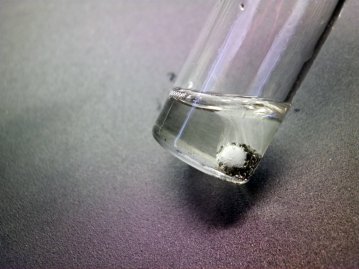EUGENE, Ore. -- (Nov. 22, 2011) -- University of Oregon chemists have developed a boron-nitrogen-based liquid-phase storage material for hydrogen that works safely at room temperature and is both air- and moisture-stable -- an accomplishment that offers a possible route through current storage and transportation obstacles.
 Reporting in a paper placed online ahead of publication in the Journal of the American Chemical Society, a team of four UO scientists describes the development of a cyclic amine borane-based platform called BN-methylcyclopentane. In addition to its temperature and stability properties, it also features hydrogen desorption, without any phase change, that is clean, fast and controllable. It uses readily available iron chloride as a catalyst for desorption, and allows for recycling of spent fuel into a charged state.
Reporting in a paper placed online ahead of publication in the Journal of the American Chemical Society, a team of four UO scientists describes the development of a cyclic amine borane-based platform called BN-methylcyclopentane. In addition to its temperature and stability properties, it also features hydrogen desorption, without any phase change, that is clean, fast and controllable. It uses readily available iron chloride as a catalyst for desorption, and allows for recycling of spent fuel into a charged state.
The big challenges to move this storage platform forward, researchers cautioned, are the needs to increase hydrogen yield and develop a more energy efficient regeneration mechanism.
(NEWS UPDATE, Dec. 12, 2011: The U.S. Department of Energy announced new grants totaling $7 million to support projects involving hydrogen storage. Among them is up to $2 million to the University of Oregon for Shih-Yuan Liu to expand his efforts on the research described here. This UO grant also includes collaboration with the University of Alabama and the Pacific Northwest National Laboratory. Full DOE announcement)
 "In addition to renewable hydrogen production, the development of hydrogen storage technologies continues to be an important task toward establishing a hydrogen-based energy infrastructure," said Shih-Yuan Liu, professor of chemistry and researcher in the UO Materials Science Institute.
"In addition to renewable hydrogen production, the development of hydrogen storage technologies continues to be an important task toward establishing a hydrogen-based energy infrastructure," said Shih-Yuan Liu, professor of chemistry and researcher in the UO Materials Science Institute.
The U.S. Department of Energy, which funded the research, is shooting to develop a viable liquid or solid carrier for hydrogen fuel by 2017. The new UO approach differs from many other technologies being studied in that it is liquid-based rather than solid, which, Liu says, would ease the possible transition from a gasoline to a hydrogen infrastructure.
"The field of materials-based hydrogen storage has been dominated by the study of solid-phase materials such as metal hydrides, sorbent materials and ammonia borane," Liu said. "The availability of a liquid-phase hydrogen storage material could represent a practical hydrogen storage option for mobile and carrier applications that takes advantage of the currently prevalent liquid-based fuel infrastructure."
The key is in the chemistry. Liu's team originally discovered six-membered cyclic amine borane materials that readily trimerize -- form a larger desired molecule -- with the release of hydrogen. These initial materials, however, were solids. By tweaking the structure, including reducing the ring size from a 6- to a 5-membered ring, the group succeeded in creating a liquid version that has low vapor pressures and does not change its liquid property upon hydrogen release.
Initially, Liu said, the new platform could be more readily adopted for use in portable fuel cell-powered devices.
Co-authors on the paper were doctoral students Wei Luo and Patrick G. Campbell, and Lev N. Zakharov of the Center for Advanced Materials Characterization in Oregon (CAMCOR).
About the University of Oregon
The University of Oregon is among the 108 institutions chosen from 4,633 U.S. universities for top-tier designation of "Very High Research Activity" in the 2010 Carnegie Classification of Institutions of Higher Education. The UO also is one of two Pacific Northwest members of the Association of American Universities.
Media Contact: Jim Barlow, director of science and research communications, 541-346-3481, jebarlow@uoregon.edu
Source: Shih-Yuan Liu, assistant professor of chemistry, 541-346-5573, lsy@uoregon.edu